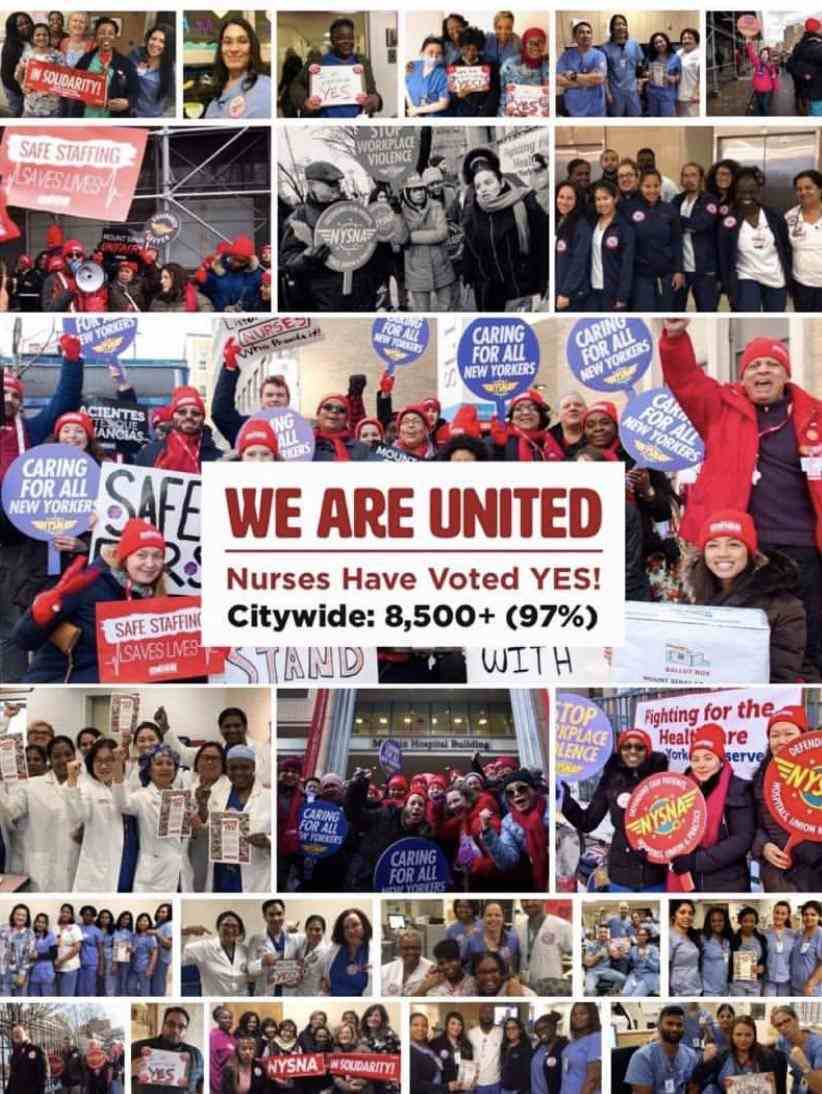This Is Why 12,000 NYC Nurses Might Strike In April 2019

By Chaunie Brusie
Updated March 23, 2019 at 4:30pm
On the evening of March 22nd, nurses all over New York City were notified that the strike scheduled to happen on April 2nd, has been withdrawn. The New York Hospital Alliance released a statement after a day of negotiations with the union, the New York State Nurses Association (NYSNA).
Bargaining Update for March 22, 2019
Today, we had a productive bargaining session with NYSNA and an impartial mediator. We made significant progress on the important issue of additional nurse staffing. NSYNA agreed to withdraw its strike notice for April 2nd and the parties agreed to resume negotiations with the continued assistance of the mediator on Wednesday, March 27th.
Just because the 10-day notice has been withdrawn does not mean the strike is completely off, however. Both parties - the NYSNA and the New York Hospital Alliance - must craft a new contract agreement. Until that happens, the union can still declare a new date for the strike.
We will find out more on Wednesday, March 27th, when both parties will meet again for negotiations. Stay tuned for updates!
Original Post 3/19/2019 at 5:00 pm PST
Three of New York City’s largest hospitals are facing what could be the city’s largest organized strikes, with 13,000 nurses from Upper Manhattan and the Bronx agreeing to strike if hospital management does not reach a deal with the state’s nursing union, New York State Nurses Association, by April 2. The primary issue behind the strike is the nurses’ call for improved safe staffing ratios. According to the union, the goal is to set safe staffing ratios in all the nurses’ contracts.
So far, however, the prospects to reach a deal are not looking good.
NYC nurses want safe staffing ratios
As Heather May, 33, New York City, a board-certified nurse in Med-Surg at Mount Sinai St Luke’s Hospital explains, there have been over 30 negotiating meetings with hospital management, but according to May, hospital administration has refused to even discuss safe staffing ratios. Each of the three hospitals—Montefiore, Mount Sinai, and NewYork-Presbyterian—has their own set guidelines for staffing, but she adds that none of them have been working “for years.”
“Nurses are mentally and physically exhausted,” May says frankly. “We are overworked. We need management to acknowledge that we are at the bedside 24/7, 365 days a year and we know what is required to provide quality care. As nurses, we joined this profession to heal and provide compassion to those who are ill. Our working conditions do not allow us to fulfill our purpose.”
And poor staffing ratios extend beyond the sheer exhaustion of the nurses working the floor; as May notes, poor staffing also ultimately affects the patients and our community they live in and serve.

Image courtesy of Heather May
97% of nurses from 3 hospitals vote “yes” to strike
With frustration growing on all sides as union nurse negotiators work to improve conditions and floor nurses work without proper staffing or breaks, May notes that the union took a Strike Authorization Vote and 97% of 13,000 nurses from the three different hospital system voted yes to strike.
Despite the nearly unanimous vote to strike, May explains that the union—and the nurses that comprise it—absolutely do not want to strike, but feel that the move is a necessary one to advocate for the quality care that their patients deserve.


Nurses don’t want to strike - it is the last resort in the best interest of patient care
“Going on strike is our last resort to show the employers that nurses are serious and passionate about this movement,” she says. “We want a fair contract that includes safe staffing ratios so we can provide quality care. so passionate that they are willing to forgo pay while being on the picket line. We know from working on the units and floors that safe staffing saves lives.”
May describes the atmosphere in the hospital as “very tense” as the April 2 deadline, but notes that she, along with many other nurses, are determined to see their fight for better care for their patients out through the end. “ extremely nervous but this is something I believe in,” she says. “I planned ahead, put more money into savings, and paid my rent in advance because my sole focus is getting a contract with safe staffing ratios.”

Taking patient care from the bare minimum to extraordinary
In May’s mind, she, along with her colleagues, aren’t just fighting for their own nurses, but for nurses around the world who are also fighting against poor working conditions. She hopes that ultimately, in addition to achieving their goal of securing safe staffing ratios for their own NYC nurses, that they will also be able to provide hope and motivation for others to mobilize to change their own working conditions.
As just one example of the difference that a proper safe staffing ratio can make, May recalls one of the last times she actually felt like she could provide quality care to her patients—all the way back on January 8th.
“This is the first morning I left the hospital feeling like an excellent nurse in a long time!!!” the nurse shared. “I was actually able to spend quality time with my patients. My 95+-year-old shared her secrets to a long life while I helped brush her teeth and wig, visited with a former patient and saw his wounds were healing incredibly well, and my cute little non-interactive patient finally spoke to me and took her meds with a hassle. And then to walk out to this beautiful sunrise! What a blessing!”
In contrast to the heartwarming scene of a satisfied nurse and patient set against the backdrop of a sky lighting up the day, May notes that since then, she has been forced to work understaffed and has not been to provide any basic grooming to my patients, just the bare minimum of medications and toileting.
And while spending quality time with patients and grooming a wig may not seem like a big deal in the grand scheme of themes, it’s exactly those little moments that matter to patients and their families—and takes nursing care from the minimum to the extraordinary.
“I would like the public to know is that this fight is ultimately for them, our patients, our community”
“We aren’t talking about wages or economics... simply want the hospital to hire more nurses so that each patient gets the quality care they deserve.”





